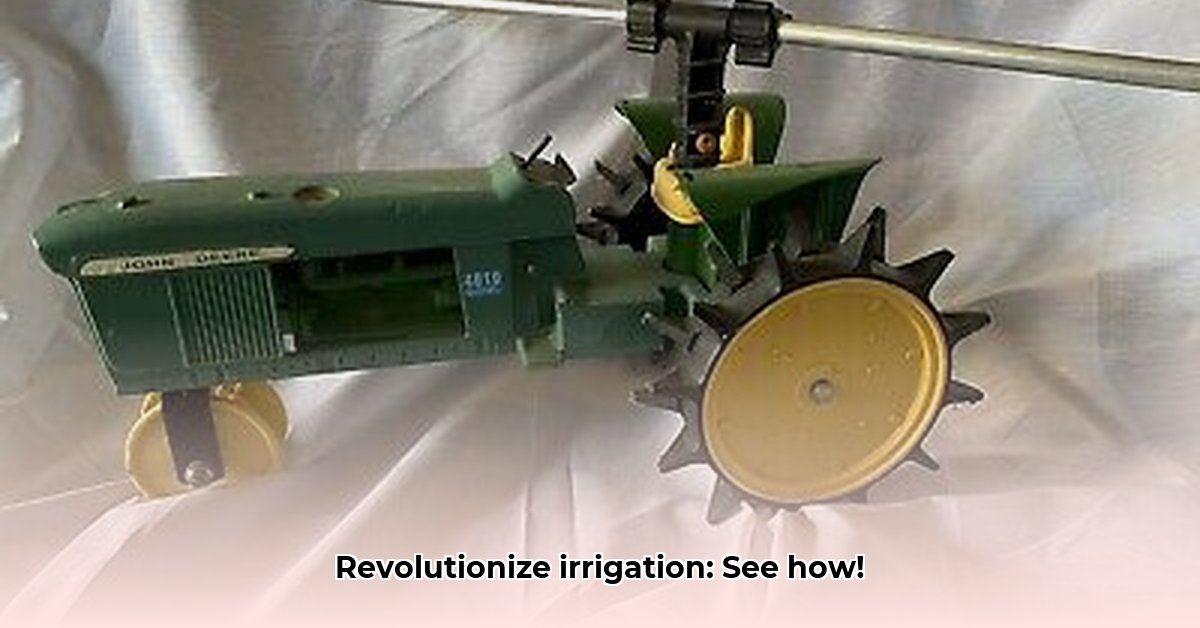
Let's revolutionize your farm's irrigation with automated sprinkler systems, focusing on the efficiency and sustainability advantages offered by John Deere (or comparable) models. Efficient irrigation isn't just about maximizing yield; it's about responsible resource management and ensuring a healthy planet. This guide will help you choose, install, and maintain a system that optimizes water use while boosting your bottom line. For more on specialized equipment, check out this helpful resource on John Deere attachments.
Assessing Your Irrigation Needs: A Tailored Approach
Before selecting a sprinkler system, thoroughly evaluate your farm's unique requirements. This crucial step prevents costly mistakes and ensures you get the most out of your investment. Consider these key factors:
- Farm Size: The acreage significantly impacts system size. Smaller farms might benefit from self-propelled sprinklers, while larger operations often require tractor-pulled systems like John Deere models.
- Crop Type: Different crops demand varying water levels. Research your specific crops' water needs for optimal irrigation.
- Water Availability: Limited water resources necessitate highly efficient systems with features like automatic shutoff valves and soil moisture sensors.
- Budget: Automated irrigation signifies a considerable investment. Factor in equipment costs, installation, and ongoing maintenance, balancing initial expenses with long-term savings.
- Terrain: Uneven terrain might necessitate specialized systems or installation techniques.
To streamline your decision, use this simplified decision tree:
- Farm size under 5 acres? Consider a smaller, self-propelled sprinkler system.
- Farm size over 5 acres? Investigate larger systems, such as John Deere sprinkler tractors.
- Limited water supply? Prioritize water-efficient models with smart features.
- Uneven terrain? Consult a specialist for optimal system design.
Choosing Your Automated Irrigation System: Key Features to Consider
Once you've assessed your needs, explore available systems. While specific John Deere model details may vary, crucial features remain consistent across reliable brands. Remember, this isn't solely about John Deere; many manufacturers offer excellent automated irrigation solutions.
| Feature | Small System (e.g., Self-Propelled) | Large System (e.g., John Deere Sprinkler Tractor) | Considerations |
|---|---|---|---|
| Coverage Area | Smaller fields | Larger fields | Must precisely match your field size and crop layout. |
| Water Pressure | Typically lower | Typically higher | Consider your water source capacity and system pressure tolerance. |
| Propulsion | Self-propelled (battery or engine) | Tractor-powered | Impacts initial investment and ongoing operating costs; consider fuel efficiency. |
| Ease of Maintenance | Generally simpler | Can be more complex | Factor in time, resources, and potential repair costs; professional help might be needed. |
| Initial Cost | Lower | Higher | Weigh the initial investment against long-term savings and increased yields. |
| Efficiency Features | Basic controls, potentially some sensors | Advanced features (e.g., GPS guidance, soil sensors) | Efficiency features directly impact long-term water & energy costs. |
Don't forget: Thoroughly compare models from different manufacturers, focusing on features that align with your specific needs and budget.
Installation and Operation: A Step-by-Step Guide
Proper installation is crucial for system longevity and efficiency. While smaller systems might allow for DIY installation for experienced individuals, larger automated systems almost always require professional installation to ensure safety and optimal functionality.
General Installation Steps:
- Site Preparation: Clear the area, level the ground (if necessary), and carefully mark out your irrigation layout.
- Water Source Connection: Ensure a reliable water source with sufficient pressure and flow. Professional assistance is often recommended.
- System Assembly: Follow the manufacturer's instructions precisely. Taking your time avoids future problems.
- Testing: Run a test before full-scale use to identify and resolve any initial issues.
- Calibration: Fine-tune the system to achieve even water distribution; many systems utilize software or control panels for adjustments.
Maintenance and Troubleshooting: Ensuring Long-Term Performance
Regular maintenance is vital for prolonging your system's lifespan and maximizing efficiency. This proactive approach prevents costly repairs and ensures optimal performance year after year.
Maintenance Checklist:
- Regular Inspections: Check for leaks, clogs, and damage to pipes and components.
- Cleaning: Clean filters and nozzles regularly to ensure even water distribution and prevent clogging.
- Lubrication: Lubricate moving parts as recommended by the manufacturer.
- Winterization: In freezing climates, winterize your system to prevent damage from freezing water.
Common Problems and Solutions:
- Clogged Nozzles: Clean or replace nozzles.
- Low Water Pressure: Check for leaks or obstructions in pipes.
- Uneven water distribution: Adjust nozzle positions or replace faulty components. Professional assistance may be required for complex diagnoses.
Sustainability Considerations: A Responsible Approach to Irrigation
Sustainable irrigation goes beyond maximizing yields. Consider the system's environmental footprint: water usage, energy consumption, and material sourcing. Even the most efficient systems consume resources. Minimize your impact by:
- Implementing smart irrigation technologies: Soil moisture sensors and weather tracking optimize water usage.
- Practicing water conservation: Efficient irrigation directly reduces your water footprint.
- Choosing durable materials: Opt for systems built from sustainable or long-lasting materials to reduce replacements.
- Ensuring regulatory compliance: Stay informed about local water usage regulations.
Efficient irrigation is a win-win: boosting your farm's productivity while contributing to environmental sustainability.